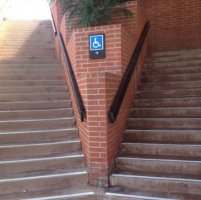BayPointArchitect
Sawhorse
Given:
A mix of ramps, vertical transitions, sidewalks, and parking spaces. All of which are located in the public right of way.
Governing codes:
2010 ADA
2012 IBC
2012 NFPA 101
The attached images do not relate to my specific condition. I am reluctant to post pictures of the area of interest because of pending litigation.
An experienced inspector for public works department explains that a ramp located within the public right of way is not required to have hand rails on both sides.
And there are a few other code-related discrepancies that do not relate to an accident-injury. Generally speaking, this downtown area is more than 100 years old. So there are plenty of (historic) things to pick at.
Question:
Do these codes only apply to building and structures located within the boundaries of a single property?
Or do these regulations also apply to all areas that are contiguous with public streets and public property?
In other words, how are these guidelines enforced within the public right of way?
Thank you
ICC Certified Plan Reviewer
NFPA Certified Fire Plan Examiner
A mix of ramps, vertical transitions, sidewalks, and parking spaces. All of which are located in the public right of way.
Governing codes:
2010 ADA
2012 IBC
2012 NFPA 101
The attached images do not relate to my specific condition. I am reluctant to post pictures of the area of interest because of pending litigation.
An experienced inspector for public works department explains that a ramp located within the public right of way is not required to have hand rails on both sides.
And there are a few other code-related discrepancies that do not relate to an accident-injury. Generally speaking, this downtown area is more than 100 years old. So there are plenty of (historic) things to pick at.
Question:
Do these codes only apply to building and structures located within the boundaries of a single property?
Or do these regulations also apply to all areas that are contiguous with public streets and public property?
In other words, how are these guidelines enforced within the public right of way?
Thank you
ICC Certified Plan Reviewer
NFPA Certified Fire Plan Examiner


